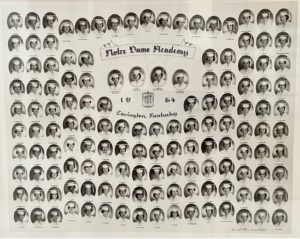by Nancy Stratman, NDA Archivist
In 1992, the Disney feature film “Aladdin” opened in theaters inviting the public to take a ride on a magic carpet to see new sights and seek out new adventures. How apropos that song would have been in October of 1963, as 531 young ladies, 33 faculty members and 13 staff members turned from Dixie Highway onto the newly established Hilton Drive, crested the hill and caught their first sights of their new home at Notre Dame Academy.

The new building, “shining, shimmering, and splendid”, beckoned to them as they drove down the newly paved road. “A dazzling place they never knew” invited them to explore new worlds of academic adventures, social interactions, religious growth and personal journeys: “a whole new world, with new horizons to pursue”. (“A Whole New World”, lyrics by Tim Rice) Grounded firmly on the solid foundation instituted by Sr Mary Agnetis in 1906, a new generation of high school students began their journey on Hilton Drive based on the same spirit that had been an integral force in all students who walked through the doors on 5th. As Sr. Agnetis was fond of saying, “A new Notre Dame? Never! A new building? Yes!”.
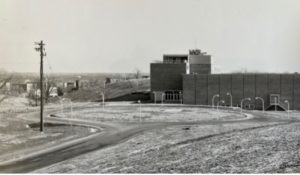
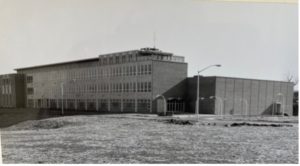
As the new home of Notre Dame Academy, the campus on Hilton Drive was designed to incorporate all of the most modern educational facilities needed to provide a first class learning environment for the young women who would walk through the doors every day: 17 standard classrooms decorated in bright colors, with a wall of windows on one side to allow for natural light, 3 fully equipped science labs, 2 modern business practice rooms, 3 home economic labs featuring dedicated spaces for food preparation, sewing and home management, facilities for athletic activities and studios for musical and artistic growth. However, continuing traditions from 5th street would also be important. Thus, no matter which entrance you used to access the new building, a familiar statue of Mary, Our Mother still greeted each student, each faculty member, each alumna, each parent and every community guest.
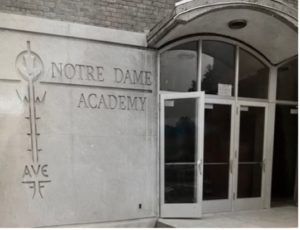
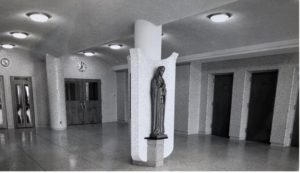
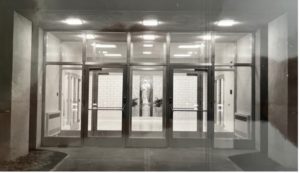
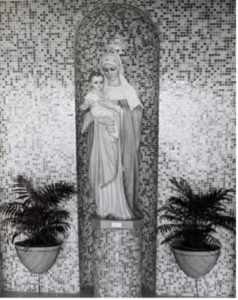
Junior Kathy Gamm wrote of the how the statue of Mother Mary helped to cross the bridge from old to new and bring the “spirit of Notre Dame” to its new residence. “In a way, this statue is very like the famous Notre Dame spirit. Its simple dignity is carried through in every detail. Each line of the statue is graceful in its simplicity, and in the same way, every aspect of our school spirit is esteemed for its unity. In another sense, however, this carving is very unlike our school spirit. As the years pass, Mary’s statue may lose some of its beauty and elegance, but that could never happen to our Notre Dame Academy spirit. This wonderful spirit which started on Fifth Street with only six girls in the first class, has been carried on there for more than 50 years, growing more wonderful with age. And now it will continue, although our address has changed to Hilton Drive in Park Hills. And this spirit will be passed on by our present students with a deep sense of simple dignity and love of Mary.” (The Gavel, November 1963)
During the summer of 1963, the 5th Street building had been emptied of all components needed to hold class. Desks, lab tables and cafeteria equipment had been sold, textbooks and supplies had been boxed and put into storage and student lockers had been dismantled. Although much anticipated by all members of the NDA community, unfortunately the new school building was not yet ready when the calendar turned to September 1963. A delayed start was unthinkable, so friends and students volunteered their services in order for the school year to open on time. Trips were made to the new school with boxes and articles that could be stored there so that the old classrooms could still be utilized. Folding chairs replaced desks, and “personalized” shopping bags replaced the locker for each student.
By September, the 5th street classrooms had a decidedly “different look” than in the past, but everything was in readiness for the opening of school in the old building. When the school bell rang the morning of September 3, 1963, students could hardly wait to see what “school” would be like. The classrooms were furnished with chairs only; each student was given a shopping bag for her books. Because there were no facilities for lunch, the school day was split into two sessions: seniors and juniors met from 7:30 a.m – 12:00 noon and freshmen and sophomores from 12:30-5:00 p.m., with classes scheduled for 30-minute periods. Everyone was most cooperative. Only the plumbing system acted worse than usual; so that when one student unsuccessfully tried to drink from the fountain, we heard her comment “Don’t tell me they’ve sold the water too!” On Friday, October 11, 1963, the last classes held on the 5th Street campus were dismissed for the “great exodus” to the new campus. A two-week home study period was declared in order to give the Sisters a chance to remove the remaining articles from 5th street and to clean the new facility on Hilton Drive. “Cars, station wagons, small and large trucks were generously put at our disposal. Several Sisters took up ‘modified’ residence at the new school in order to be on the spot to receive deliveries and direct the unloading for various departments. Everything moved smoothly according to arrangements and the scheduling of morning-noon-and-night shifts. True, many of the workmen still on the job had to acquire a new skill – dodging the omni present Sisters. However, the men soon got used to us just as we got used to running into men just anywhere.” (SND Christmas letter, 1963)
Members of the SND congregation gathered together on the new campus the night of October 27th to celebrate the first Mass on the new campus. The next day all students arrived to begin their academic life on the new campus. After the distribution of schedules and homeroom assignments, Sr. Mary Immacula (principal) led the entire student body on a complete tour of the new building, followed by Holy Mass which was celebrated in the gym/auditorium. “There followed dismissal for the day, with a reminder that full sessions would carry them through an entire day beginning the next day and thereafter.” (SND Christmas Letter, 1963)
When the sun rose on Tuesday, October 29, a steady stream of cars and buses could be seen dropping off the NDA students for their first official day of class on Hilton Dr. Juniors and seniors who had wanted to drive their family cars to school that day, were asked not to, due to the fact that the large grass field in front of the school had not yet been paved for parking and tended to get muddy when it rained. It was reserved for faculty and guests.
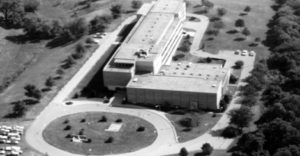
At 8:00 am, the student entrance doors were opened, and members of the faculty and staff welcomed the students to their new home.
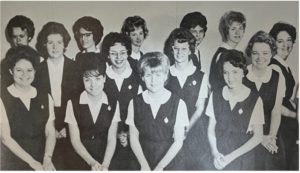
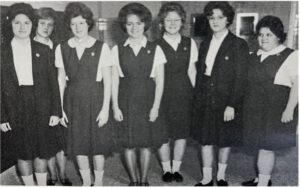
Wearing their blue sleeveless jumpers with their St. Julie medal proudly displayed on their bodice, 94 senior class members were the first to venture into their new world, many anxious as to what the new school year would be like. But fears were calmed when the familiar statue of Mary, Our Mother stood amidst the spacious lobby and welcomed them as she had always done on 5th Street. Each student quickly stepped into the old tradition of bowing her head respectfully and greeted Our Lady with the familiar prayer of welcome, “O Mary, to Thee I give the lily of my heart. Be thou its guardian forever”. Quickly 123 juniors, 160 sophomores and 154 freshmen, the older students in the traditional blue jumper while most of the sophomores and freshmen sported the new dark gray skirt, white blouse and gray blazer, confidently walked to their respective homerooms to hear morning announcements and then onto their first period classes.
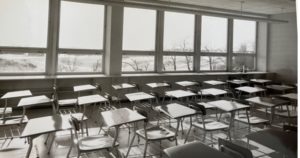

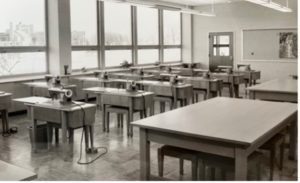
After the familiarity of 60 years on the Hilton campus, current students might find it hard to imagine how different the everyday activities of student life were changed for those young women as they transitioned from 57 years on Fifth Street. No more makeshift classrooms from converted hallways and storage rooms, no more sharing outdated science lab equipment or sewing on machines that had been “repaired” once too often. No more walking to and from St. Aloysius for gym classes. No more dividing lunch times into small groups in order to accommodate students. No more creaking stairwells and bits of plaster ceilings falling like snowflakes during class. The new classrooms were large, airy and well-lit. The library had plenty of room for both individual research and group study. Science microscopes, sewing machines and office typewriters were of the latest design. A spacious gym allowed for full-scale PE classes and intramural sports, as well as doubling as an assembly auditorium which allowed for comfortable seating for the entire student body at the same time. The cafeteria was bright and airy, featuring a bank of windows allowing for natural light and large enough to accommodate an entire grade level for lunch.
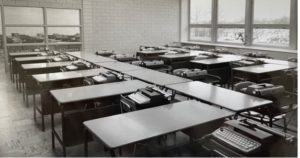
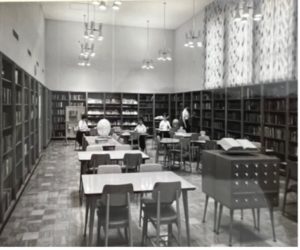
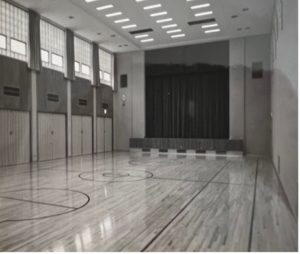
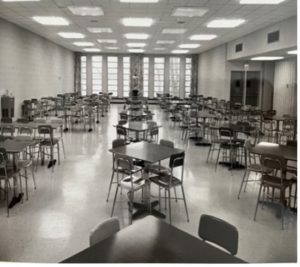
And yet, with all of the emphasis on the new structural building, the adherence to academic guidelines, school policies and procedures as well as the celebration of long held traditions, many of which had found their roots throughout the long history of the academy, is what kept the essence of the Notre Dame Academy spirit alive and flourishing during this new era.
Academic Studies
In 1963, the bulk of the faculty were the Sisters of Notre Dame; 28 sisters taught the majority of classes in every discipline: religion, math, science, history, English, foreign languages, music, art and secretarial subjects. They also provided guidance services for all four grade levels. There was one clergy on the faculty – Fr. Raymond McClanahan who taught freshman and sophomore religion. In addition, four lay teachers were hired to fill in a few vacancies: Mrs. Mary Grober (Physical Education and Health), Miss Marguerite Casello (Secretarial Studies), Miss Marilyn Murphy (United States History) and Mr. Clyde Herdon (Choral Director).
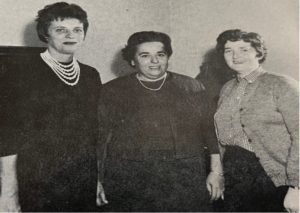
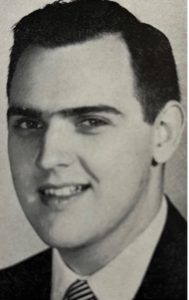
The school day started at 8:20 a.m., with students reporting to their homerooms for announcements. There were 6 academic class periods, 1 guidance period for each grade level and one lunch period for each grade level. All academic periods were 60 minutes long, with the guidance and lunch periods being 30 minutes each.
In 1963, Notre Dame Academy offered two different courses of study from which students could choose: Academic or General. “All students are required to take certain studies because these are essential for the accomplishment of the ultimate goal of a Christian education and are necessary to meet state educational requirements. The electives provide for the intellectual abilities of the student, preparation for college, professional training and special interests. Electives are determined by the qualifications and academic record of the student.”
(NDA Handbook for Parents and Students, 1963-64)
The academic course was structured to prepare the student for entry into a four-year college. Required classes for each grade level included:
Freshman – Religion, English, Latin I, Algebra, World History and Health/PE
Sophomores – Religion, English, Latin II, Geometry, Biology, Music Appreciation/Speech
Juniors – Religion, English, Latin III or French I, Algebra II, US History and one elective course (Physics, Chemistry, Art, Typing or a second language)
Seniors – Religion, English, Latin IV or French II, Math IV or second language, and two elective courses (Chemistry, Physics, Speech, Problems of Democracy, Typing, Art)
The general course was structured to prepare the student for entry into the business world directly from high school. Required class for each grade level included:
Freshmen – Religion, English, Home Economics I, Basic Math, World History, Heath/PE
Sophomores: Religion, English, Biology, General Math, Music Appreciation/Speech, and one elective (Home Economics II or Art)
Juniors – Religion, English, US History, Typing, and two electives from two different groupings (Group #1: Stenography, Bookkeeping, Art), (Group #2: Bookkeeping, Physical Science)
Seniors – Religion, English, Problems of Democracy, Typing and two electives from two different groupings (Group #1: Science, Bookkeeping, Speech, Art), (Group #2: Stenography, Office Practice)
Private lessons were also offered in voice, instrumental music and art for interested students in addition to the normal course of study.
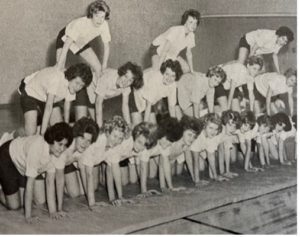
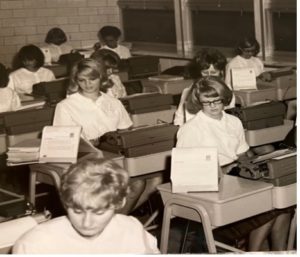
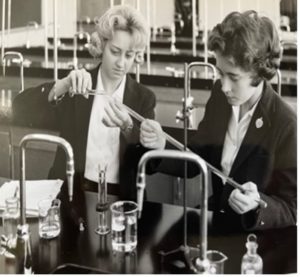
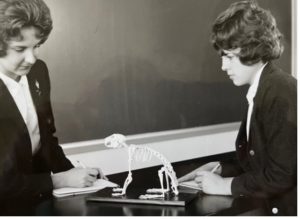
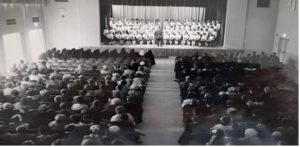
Character Formation
Beginning with the establishment of the NDA High School in 1906, Sr. Mary Agnetis set the standard for the development of study habits and personal qualities which would lead to “gracious womanly living.” (Sr. Agnetis, 1910). In the 1963 Parent/Student Handbook, there are several pages dedicated to the formation of character that each student was expected to embrace:
“A true Notredamian is noted for her loyalty. A student who is loyal will take pride in living up to the ideals of Notre Dame Academy. She will remember that it is a matter of personal honor to act on principle. At Notre Dame Academy, attention was called to courtesy, poise, industry, neatness and proper grooming. To become true and finished women of character, all students at Our Lady’s Academy will strive to observe:
- Courtesy – They will manifest respect and reverence for others by greeting them, by giving precedence, by speaking to them and of them in a respectful manner, by listening when others speak to them, by rising when someone to whom they owe deference speaks to them or enters or leaves the room. They will graciously offer assistance to teachers and classmates by carrying books, erasing the boards, opening and closing doors and similar acts of thoughtfulness. They will observe pleasing table manners. They will express gratitude, apology or sympathy on appropriate occasions. They will co-operate by observing school regulations and procedures.
- Poise – They will conduct themselves and speak in a ladylike manner at all times. They will observe correct sitting and standing postures. They will modulate their speaking voices and laughter. They will not chew gum in public.
- Industry – They will prepare assignments well, participate actively in class and have all necessary equipment. They will promptly make up work missed due to absence.
- Neatness and proper grooming – They will observe neatness in all written assignments. They will keep their books, notebooks and lockers orderly. They will wear the prescribed uniform and it will be kept neat and orderly. They will keep their hair arranged in an orderly and appropriate style for school. They will wear the prescribed uniform for gym class and keep it neat, clean and orderly. Whenever they report at school for any function, they will be properly groomed. Shorts are not ordinarily permitted on the premises.
The student handbook also gives several examples of how these attributes of character formation translated into everyday school life. For example, there was a strict uniform policy for both everyday school wear as well as for gym classes.
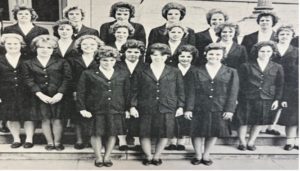
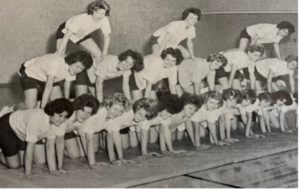
The primary school uniform consisted of a white button-down blouse (long or short sleeve), a charcoal grey skirt and a charcoal grey blazer. The blazer was not required for everyday class but was required for special events. Sweaters were prohibited and not considered part of the uniform code. Accessories were limited to a silver NDA lapel pin, no jewelry other than the class ring, black shoes (no gym shoes or Keds) and white anklets or clear hose. The gym uniform consisted of navy bermuda shorts, a white cotton button-down blouse, white anklets or knee sock and gym shoes.
Another example from the student handbook describes “traffic regulations” to be followed within the school halls. “Throughout the building students will not speak above a refined conversational tone at any time. Students will observe all traffic regulations. In the corridors and on the stairways, students will walk, never run. At the change of classes, in going to the cafeteria and at dismissal, students will keep to the right and walk in single file. They will use the designated stairway for up and down traffic. When a class moves from one classroom to another, the students will keep to the right in a single file, walk to the end of the corridor, turn and continue on their right to the classroom or proper stairway. Precedence is always given to those leaving the classroom. Those waiting to enter will always stand in a single file line. When leaving a classroom, students should give precedence to the teacher, always go to the door in proper order, and only one student at a time through the doorway.
A third example discusses proper behavior for the cafeteria. “All students will eat in the cafeteria for the noon lunch. Students will move quickly and quietly through the serving line and then to a table in the cafeteria. They will graciously fill in any vacant places when this is necessary. Students will not move furniture but adapt themselves to circumstances and to the wishes of others. They will say grace before and after meals. They will observe etiquette while eating and respond courteously to the suggestions and directions given by the supervisor. When students leave the table, they will see that it is clean and in a condition agreeable for the next person to have lunch. No food or drink may be taken anywhere in the school or on the premises outside the cafeteria or snack lounge. Eating of all kinds of food and drinking of soft drinks is forbidden except in these two places.
All students were encouraged to participate in at least one extracurricular activity during their high school years. “Membership in a club contributes to the spiritual, intellectual and cultural development of the student according to the specific aim of the club, in addition to giving the students an opportunity to work with others and gain leadership experience.” (1963 NDA Student Handbook)
There were eight co-curricular activities listed in the 1963 handbook:
– the objective of the Confraternity of Christian Doctrine (CCD) was to spread the knowledge and practice of the Catholic faith. Students who were members of CCD could receive a certificate which qualified them to teach Christine Doctrine during their senior year to Catholic children attending public schools.
– the Legion of Mary was an association of Catholics who promoted membership as a “service in the warfare which is waged constantly by the church against the forces of evil”. One of the primary activities of the Legion of Mary at NDA was the recitation of daily rosary.
– the Catholic Students Mission Crusade (CSMS) was a unit of the national organization which sought to develop an apostolic zeal for the cause of Christ at home and abroad through the missionary spirit.
– the purpose of Student Council was to develop in the student a sense of responsibility, a readiness to sacrifice for the common good and a wholesome spirit of cooperation and thus train for Catholic leadership.
– the Press Club promoted the importance of the printed page in the modern world and required each student to “observe critically, to inquire extensively, to write precisely and truthfully, as well as learn to be tactful in public relations, subordinate personal opinions, and to work harmoniously with others.” Members of the Press Club produced the award- winning feature magazine, The Gavel.
– the National Forensic League was an honor society organized to “promote the interests of interscholastic debate, oratory and public speaking.
– the Library Club was open to all students interested in reading books as well as offering members the opportunity to participate as ‘library assistants” on certain days every week.
– the Red Cross club was a unit of the National Junior Red Cross Association and gave students the opportunity to be of service to others by working on community projects.
As well as these activities, students who had an interest in chorus and/or dramatics had opportunities to participate in choral events or in the production of the annual school play. Last, but not least, was the opportunity for students to participate in intramural volleyball and bowling teams, which included established league play and tournaments.
Traditions Continue
From the start of the school year, Sr. Immacula (principal) and the faculty knew that a successful transfer from old to new would include not only a continuation of rigorous academic standards and spiritual growth opportunities, but also carrying on the beloved cultural and social activities.
Thus, even before the new campus was officially opened, traditions carried on. The senior class hosted the freshmen at their annual Senior-Freshmen Big Sister event on September 22, 1964. Held at Devou Park, the seniors provided several activities so that the two classes could successfully forge the bond of sisterhood. A scavenger hunt, a water balloon contest and a hootenanny culminated in a picnic lunch enjoyed by all.
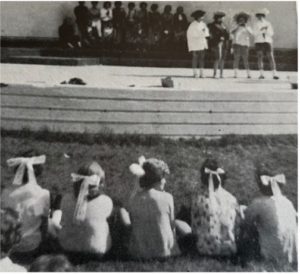
Seniors Gail Junker and Geraldine Hehman won first place in the RCA Victor Week, a contest that asked local student artists to design a store front window advertising color television. Their depiction of Donald and Daisy Duck, Pluto and other cartoon characters watching a TV was featured at Bob Averdick’s Furniture Store on Dixie Highway during the week of September 29th through October 5th. The school received a new television set for the newly established audio-visual room.
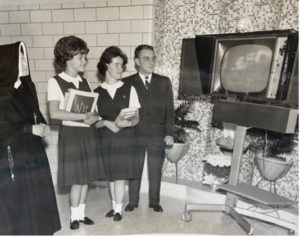
On November 18, 1963 the entire student body gathered in the new auditorium and witnessed the installation of the newly elected student council and class officers. Pledging their loyalty to Notre Dame Academy and their assistance to their fellow officers in student council, Mary Ann Egi was sworn in as president, Kathy Burke (vice-president), Martha Purcell (secretary) and Paula Ossenbeck (treasurer). Class officers included Jane Grote (senior), Barbara Schoborg (junior) and Patricia Burke (sophomore).
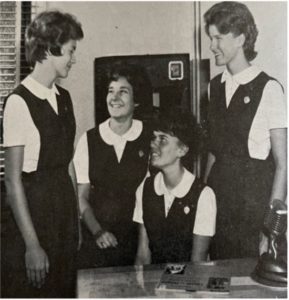
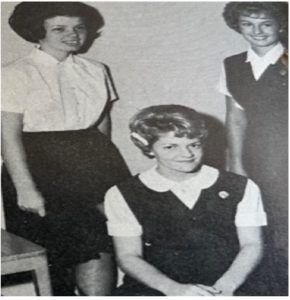
Continuing the tradition of bringing school news, activity updates and student opinions on community topics, a trio of new leaders took the reins of The Gavel. Nancy Nienaber (editor-in-chief), Annalee Schlesinger (managing editor) and Susan Hackman (business manager) also welcomed moving from a cramped office on the third floor of the old building to a spacious and airy room on the first floor in the new building.
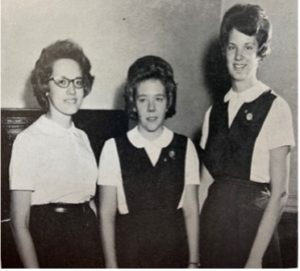
After the start of the new year in January, seniors gathered in the new chapel celebrating Mass and receiving their class rings. At this Mass, seniors thanked God for their very special ring that symbolized the sisterhood of Notre Dame Academy. Upon receiving their ring, each senior repeated the following prayer pledging their loyalty to Notre Dame Academy:
“Encircle my finger, O
Torch that I bear.
Emblazon your message, O
Ring that I wear.
Notre Dame’s song, O
Truth from above
Intone in my heart, forever
Your love.”
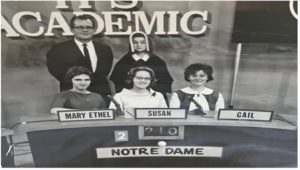
On January 22, students gathered to watch three seniors compete on the popular TV show “It’s Academic”. Mary Ethel Parrot, Susan Hackman and Gail Junker. Competing against students from Greenhills and New Richmond, NDA finished in 2nd place and brought back to the school a 10-volume set of “Gateway to the Great Books” which was given to the library.
The first year on the new Hilton Campus concluded with a variety of activities both new and very traditional. On April 1, a long-standing tradition at Notre Dame Academy was continued when 91 members of the senior class, along with two chaperones, boarded the train at Union Terminal bound for New York City by way of Washington DC. After 14 hours of travel, the students visited such sights as the National Shrine of the Immaculate Conception, the Smithsonian Museum, the Capitol and the White House, before traveling on to New York City. The two days in New York were spent touring the UN Building, the Empire State Building, Chinatown and Rockefeller Center, attending the Broadway play Here’s Love and a boat ride around Manhattan Island.
The sophomore class made history at NDA by sponsoring the first dance held at the new academy. On Friday, April 11 the “sophomores only” gathering took place in the school cafeteria. Using the theme of “Bali Hai” from South Pacific, students turned the lunchroom setting into an exotic south sea setting featuring palm trees through the room, sea nets with various “sea” decorations and a small grass hut complete with a lily pond as a background for posed pictures.
When junior and seniors entered the Lookout House on April 24, 1964, they were immediately surrounded by miniature windmills, grass huts and igloos and whisked away to “Far Away Places”, the theme for the 1964 prom. Senior Marita Ayers crowned Mary as the girls and their escorts gathered around the statue and sang “Mother Beloved”. Afterwards, junior class president Barbara Schoberg crowned Marita as Prom Princess and announced her junior court.
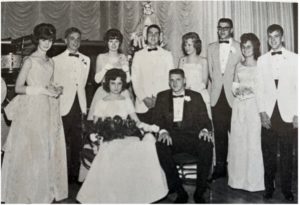
On April 27 and 28, the seniors performed their class play, The Miracle Worker, on the new NDA stage in the auditorium. The cast featured Sharon Ebel as Helen Keller, Sheila Collins as Annie Sullivan, Barbara Suttmiller as Mrs. Keller and David Lloyd as Mr. Keller. This first production at NDA was directed by Sr. Mary Charlanne assisted by Marianne Eibel as student director.
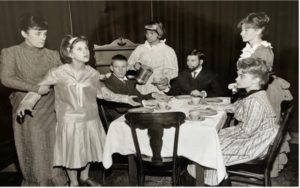
It seems only fitting that during this exciting first year on the Hilton campus, with so many new events and adapted customs, that one of the most revered traditions of Notre Damians was also rewritten. According to The Gavel, “The tradition of a junior crowning the Blessed Virgin has been broken as senior Mary Ethel Parrott won the honor of crowning Our Lady for the second time.” It was the first time in the school’s history that any girl had been bestowed the title of Mary’s Maid twice. The ceremony itself, however, remained as beautifully reverent and holy as ever. “Two seniors, who had participated in the Marian Contest for four years, led the procession, one bearing the standard and the other carrying the crown.
Carrying lighted candles, the entire student body followed praying the rosary, followed by the special guard, made up of those who participated in the Marian Contest and members of the Legion of Mary, wearing their honor capes. Lastly, the attendants, dressed in blue, green, yellow and gold, encircled the statue and paid homage while Mary’s Maid, placed the crown of flowers on Mary’s head.” (The Gavel, May, 1964)
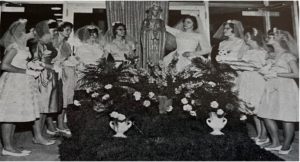
All too quickly, the end of the 1963-64 school year arrived. The novelty of the new campus had faded into everyday realities and the underclasswomen left the building that May, secure and comfortable in their new surroundings, already making plans for next year. They had but one more task to complete – saying goodbye to the trailblazing women who had successfully endured the closing of their beloved 5th Street campus and embraced the beginnings of their new home on Hilton Drive. It was through their hard work, undying enthusiasm and joyful spirit that the true essence of Notre Dame Academy, founded by Sr. Mary Agnetis in 1906, was truly replanted from Covington to Park Hills and would continue to grow for many decades.
